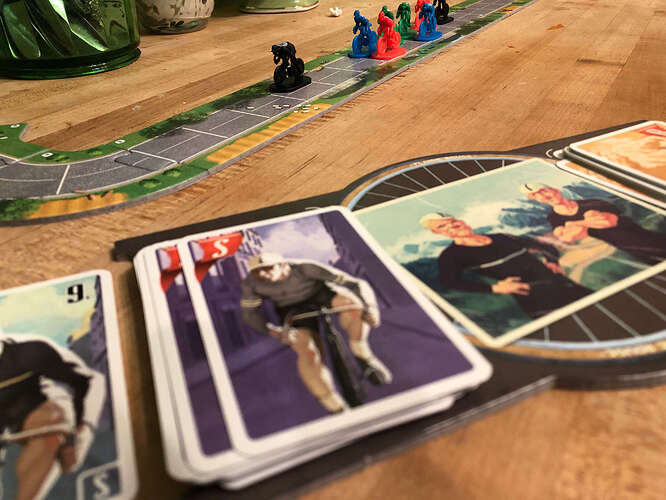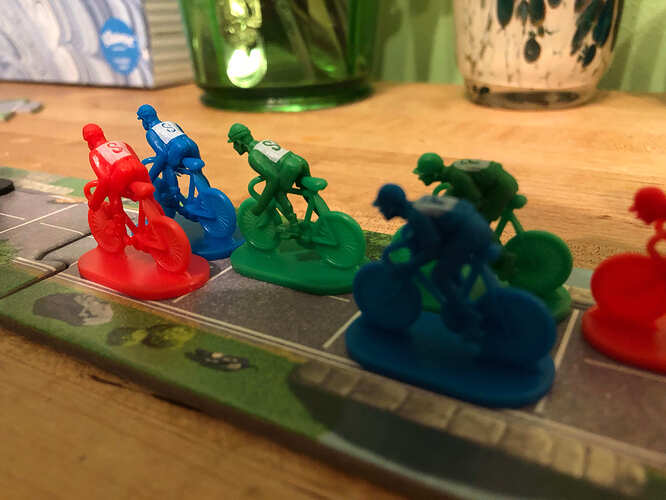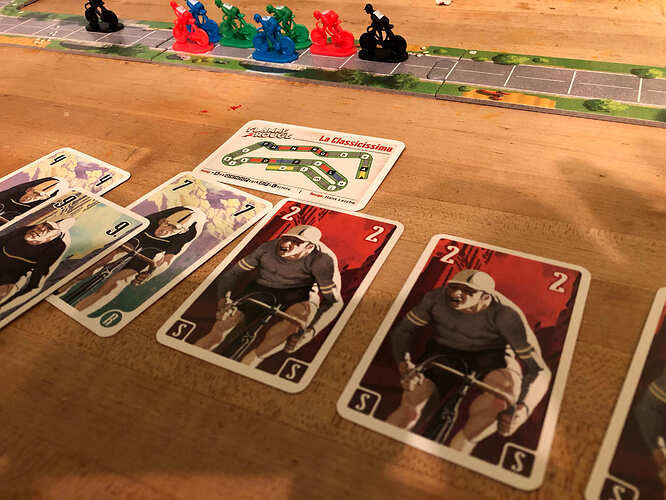Originally published at: http://statelyplay.com/2017/10/30/cardboard-critique-flamme-rouge/
Tabletop •
My bike is a recumbent–basically a recliner welded to a bike frame–which is perfect for getting my fat butt around town. And that, ladies and gents, is the full extent of my cycling knowledge. Much like all sports, cycling is something I neither participate in nor understand. Several members of my regular game group, however, are active cyclers who not only own more bikes than I’ve owned in my entire life, but, when not cycling, will sit and watch other people racing their bikes. I bought Flamme Rouge for them, thinking that getting it on the table would be an easy sell. It wasn’t, but we did finally manage to play it which led to three consecutive games in a row. In other words, it went over well.
Flamme Rouge is a racing game that focuses on the last kilometer of a bike race set in the early 1900’s, I think. The time period really doesn’t matter, but the art is very much sans men in spandex shorts and xenomorph-ish helmets, so I’m going with early 1900’s. Each player controls a Sprinteur and Rouleur–French for Sometimes Fast Guy and Jack-of-All-Trades Guy–with the goal of being the first to get one of your cyclists across the finish line.
To accomplish this goal each player is given two decks of cards, one for each cyclist. Each turn you’ll draw four cards for each rider, selecting one and placing the other three on the bottom of the appropriate draw pile. Play cards, move the number of space on the card, and repeat. As far as racing games go, they don’t get much simpler. Switching lanes is a free action, bikes can pass through other bikes, and the double-wide tracks lack any bottlenecks allowing Flamme Rouge to eschew the usual tactical track blocking present in most other racing titles.
[caption id=“attachment_3509” align=“aligncenter” width=“4032”]
In the lead means more exhaustion coming my way[/caption]The game gets interesting after all the bikes move each turn. This is when you’ll apply slipstreaming, which allows bikes to move forward if there is only one space between the pack they’re in and the pack in front of them. This combined with the fact that each player has the same decks for their riders means that all bikes tend to stay close throughout the entire race. After slipstreaming you’ll see which riders have an empty space in front of them, with those racers earning themselves an Exhaustion card–a card with only 2 movement points–into their decks. Thus, the leaders will pick up more and more exhaustion and eventually fall back into the pack. Thus, the predominant strategy is to stay within the pack, letting others grab those exhaustion cards, and then sprinting forward when the finish line comes into view.
This is easier said than done, of course, as cards are selected in secret so you’re not sure how far your opponents will be moving each turn. You’ll also send the played card back to the box, so your deck size will decrease as the race moves forward. The decision to play a high card to rejoin the pack when you’ve fallen behind seems like an easy one, except then that high card is gone at the end of the race when sprinting is necessary to pull ahead. Likewise, playing small cards to get them out of your deck early is great unless everyone else plays higher cards, leaving you alone in the back collecting Exhaustion cards each turn as you try to catch up.
[caption id=“attachment_3510” align=“aligncenter” width=“4032”]
Not mentioned in the review are how cool the little cyclists are.[/caption]On top of all this are the hills. All the included tracks but one have dreaded hill spaces. Rules don’t drastically change on hills, but it’s enough to throw everything you’ve planned up to that point out of whack. If you enter an uphill space at any point during your turn, your movement is capped at 5, and no riders in uphill spaces can benefit from slipstreaming. With luck, you can get over the uphill sections quickly, without having to spend more than one or two cards. If you’re like me, however, you’ll get stuck in the back of the pack and it will take you three or more turns just to crest a hill.
Luckily, you can make up for lost time on the downhill. If you start your turn in a downhill space, the minimum you can travel on a turn is 5, which is a good way to get rid of those damn Exhaustion cards.
That’s the game. The whole game. It’s incredibly easy to teach and, compared to some other racing titles–I’m looking at you Thunder Alley–seems simplistic. That doesn’t translate to dull, however. The slipstream and Exhaustion mechanisms are subtle, yet rewarding as hell when you master them, even if it’s only for one or two turns, and the deck management, which is the heart of the game, becomes more and more tension filled as your deck dwindles along with your movement choices.
[caption id=“attachment_3511” align=“aligncenter” width=“4032”]
I’m exhausted just writing this review[/caption]If Flamme Rouge has a downside, it’s the four-player cap. The game is screaming for 5-6 players and capping at 4 means that it won’t hit the table as often as it should. There is an upcoming expansion which adds a fifth and sixth player, however, so hope isn’t lost. Unfortunately, it’s not set to hit the US until January. For those of you in the EU, I think it was released at Essen so you should be able to grab a copy now.
Flamme Rouge is another great racing game on my shelf, and one that seems likely to get more playtime than its lengthier cousins. Much like Downforce, Flamme Rouge is another racing game that will hit the table before, after, or between the “big” game of the night. It’s light enough to not tax your brains, but tactical enough to give you a full hour of decision-making delight. Flamme Rogue has the added benefit of coming with configurable tracks and the ability to run an entire season instead of one race, something my group was already talking about doing before we finished our second game. No other racing game we’ve tried has had that reaction. I think Flamme Rouge will be hanging around for a while.



